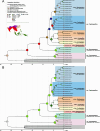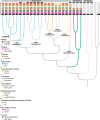Reticulate evolutionary history underpins a revised generic circumscription of Paphiopedilum (Orchidaceae): insights from integrative phylogenomics and historical biogeography
- PMID: 40885902
- PMCID: PMC12398030
- DOI: 10.1186/s12870-025-07123-3
Reticulate evolutionary history underpins a revised generic circumscription of Paphiopedilum (Orchidaceae): insights from integrative phylogenomics and historical biogeography
Abstract
Background: The taxonomy of Paphiopedilum-a diverse group of slipper orchids-has long posed challenges due to high morphological variability and conflicting phylogenetic signals. Despite intensive research, a clear and stable infrageneric classification remains unresolved.
Results: We present an integrative phylogenetic framework based on multiple nuclear low-copy genes (XDH, PHYC, LFY, RAD51, ACO, DEF4), ITS and plastid (matK) sequences, supported by morphological and biogeographical data. Our analyses consistently recovered monophyletic clades corresponding to both historically recognized and newly proposed lineages. Phylogenetic incongruence observed both between different nuclear loci and between nuclear and plastid phylogenies suggests a reticulate evolutionary history shaped by ancient hybridization events and incomplete lineage sorting. Biogeographic reconstructions place the genus' origin in mainland of Southeast Asia during the Miocene, with subsequent radiation influenced by climatic and geological events. As a result, we propose a revised classification recognizing three genera-Parvisepalum, Brachypetalum, and Paphiopedilum s.str.-with the latter subdivided into six subgenera.
Conclusions: This study provides the most comprehensive phylogenetic and taxonomic treatment of Paphiopedilum to date. Our framework reflects evolutionary relationships more accurately than previous systems and offers a stable basis for future research in orchid systematics, conservation, and evolution.
Keywords: Paphiopedilum; Biogeography; Hybridization; Molecular systematics; Orchidaceae; Phylogenetics; Slipper orchids; Taxonomy.
© 2025. The Author(s).
Conflict of interest statement
Declarations. Ethics approval and consent to participate: Not applicable. Consent for publication: Not applicable. Competing interests: The authors declare no competing interests.
Figures





Similar articles
-
Transcriptome sequencing data provide a solid base to understand the phylogenetic relationships, biogeography and reticulated evolution of the genus Zamia L. (Cycadales: Zamiaceae).Ann Bot. 2024 Nov 13;134(5):747-768. doi: 10.1093/aob/mcae065. Ann Bot. 2024. PMID: 38900840 Free PMC article.
-
Integrating genome-wide traits and multi-loci phylogeny to investigate orchid evolution-A case study on Pleurothallidinae.Plant J. 2025 Jun;122(6):e70281. doi: 10.1111/tpj.70281. Plant J. 2025. PMID: 40538196 Free PMC article.
-
Plastome phylogenomics of the diverse neotropical orchid genus Lepanthes with emphasis on subgenus Marsipanthes (Pleurothallidinae: Orchidaceae).BMC Ecol Evol. 2025 Aug 7;25(1):79. doi: 10.1186/s12862-025-02396-6. BMC Ecol Evol. 2025. PMID: 40775299 Free PMC article.
-
Orchid phylogenetics and evolution: history, current status and prospects.Ann Bot. 2025 May 9;135(5):805-822. doi: 10.1093/aob/mcae202. Ann Bot. 2025. PMID: 39545932 Review.
-
Systemic pharmacological treatments for chronic plaque psoriasis: a network meta-analysis.Cochrane Database Syst Rev. 2021 Apr 19;4(4):CD011535. doi: 10.1002/14651858.CD011535.pub4. Cochrane Database Syst Rev. 2021. Update in: Cochrane Database Syst Rev. 2022 May 23;5:CD011535. doi: 10.1002/14651858.CD011535.pub5. PMID: 33871055 Free PMC article. Updated.
References
-
- Lindley J. The Genera and Species of Orchidaceous Plants. Ridgways; 1840.
-
- Reichenbach HG, Reichenbach HG, Kraenzlin F. Xenia orchidacea: Beiträge zur Kenntniss der Orchideen. Leipzig: F.A. Brockhaus; 1858.
-
- Pfitzer EHH. Morphologische Studien über die Orchideenblüthe. Winter; 1886.
-
- Rolfe RA. The Cypripedium group. Orchid Rev. 1896;4(327–334):363–7.
-
- PfIitzer EHH. Beiträge zur Systematik der orchideen II. Botanische Jahrbücher für Systematik. 1898:517–46.
MeSH terms
Grants and funding
LinkOut - more resources
Full Text Sources
Research Materials
Miscellaneous

